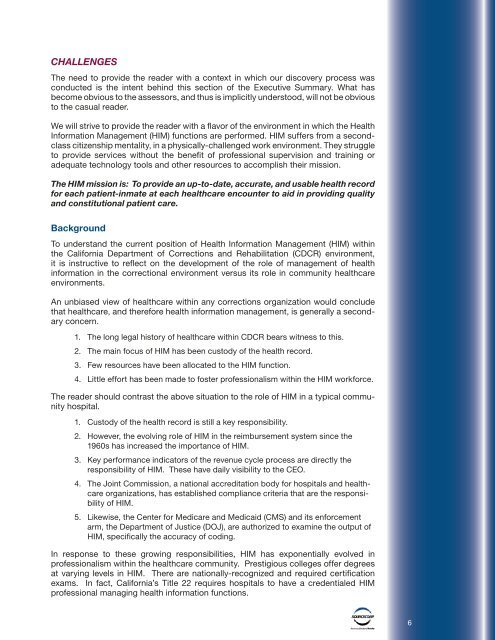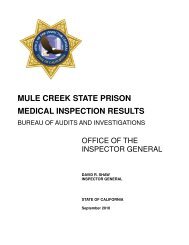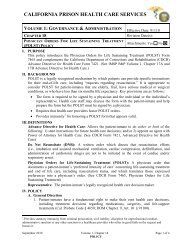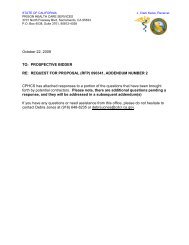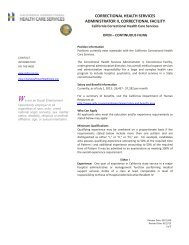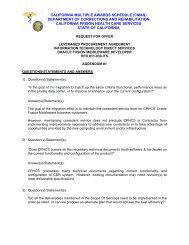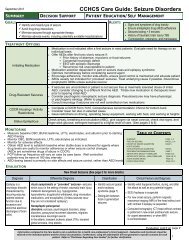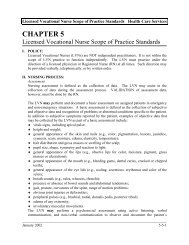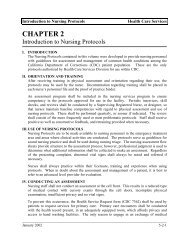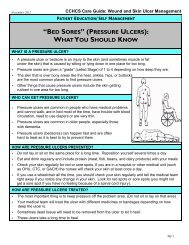Health Information Management Operational Assessment
Health Information Management Operational Assessment
Health Information Management Operational Assessment
You also want an ePaper? Increase the reach of your titles
YUMPU automatically turns print PDFs into web optimized ePapers that Google loves.
CHALLENGES<br />
The need to provide the reader with a context in which our discovery process was<br />
conducted is the intent behind this section of the Executive Summary. What has<br />
become obvious to the assessors, and thus is implicitly understood, will not be obvious<br />
to the casual reader.<br />
We will strive to provide the reader with a flavor of the environment in which the <strong>Health</strong><br />
<strong>Information</strong> <strong>Management</strong> (HIM) functions are performed. HIM suffers from a secondclass<br />
citizenship mentality, in a physically-challenged work environment. They struggle<br />
to provide services without the benefit of professional supervision and training or<br />
adequate technology tools and other resources to accomplish their mission.<br />
The HIM mission is: To provide an up-to-date, accurate, and usable health record<br />
for each patient-inmate at each healthcare encounter to aid in providing quality<br />
and constitutional patient care.<br />
Background<br />
To understand the current position of <strong>Health</strong> <strong>Information</strong> <strong>Management</strong> (HIM) within<br />
the California Department of Corrections and Rehabilitation (CDCR) environment,<br />
it is instructive to reflect on the development of the role of management of health<br />
information in the correctional environment versus its role in community healthcare<br />
environments.<br />
An unbiased view of healthcare within any corrections organization would conclude<br />
that healthcare, and therefore health information management, is generally a secondary<br />
concern.<br />
1. The long legal history of healthcare within CDCR bears witness to this.<br />
2. The main focus of HIM has been custody of the health record.<br />
3. Few resources have been allocated to the HIM function.<br />
4. Little effort has been made to foster professionalism within the HIM workforce.<br />
The reader should contrast the above situation to the role of HIM in a typical community<br />
hospital.<br />
1. Custody of the health record is still a key responsibility.<br />
2. However, the evolving role of HIM in the reimbursement system since the<br />
1960s has increased the importance of HIM.<br />
3. Key performance indicators of the revenue cycle process are directly the<br />
responsibility of HIM. These have daily visibility to the CEO.<br />
4. The Joint Commission, a national accreditation body for hospitals and healthcare<br />
organizations, has established compliance criteria that are the responsibility<br />
of HIM.<br />
5. Likewise, the Center for Medicare and Medicaid (CMS) and its enforcement<br />
arm, the Department of Justice (DOJ), are authorized to examine the output of<br />
HIM, specifically the accuracy of coding.<br />
In response to these growing responsibilities, HIM has exponentially evolved in<br />
professionalism within the healthcare community. Prestigious colleges offer degrees<br />
at varying levels in HIM. There are nationally-recognized and required certification<br />
exams. In fact, California’s Title 22 requires hospitals to have a credentialed HIM<br />
professional managing health information functions.


